Over the last century, the diagnosis and management of children with CHD has changed rapidly, founded on the work of visionary pioneers, and improved incrementally through advances in knowledge, technique, and technology. Developments in paediatric cardiology, cardiac surgery, imaging, intensive care, genetics, and other areas have radically altered the natural history of CHD, especially for those needing intervention at an early stage in their life trajectory who have the most to gain. Today, we can offer the prospect of “cure” or successful palliation in almost all structural congenital heart conditions.
Progress can be plotted through landmark articles that have made a major impact on the literature, Reference Garfield1,Reference Van Noorden, Maher and Nuzzo2 providing an insight into the evolution of a specialty. Reference Kim, Yoon and Kim3 We therefore conducted a comprehensive bibliometric analysis to identify the most cited papers in the field of structural CHD in children.
Methods
Journals listed in the 2019 Journal Citation Reports of the Web of Science (Clarivate Analytics, Philadelphia, PA) under the following subject categories were evaluated for inclusion: Cardiac & Cardiovascular Systems (138 journals); Critical Care Medicine (12); Genetics & Heredity (9); Medicine, General & Internal (14); Multidisciplinary Science (4); Pediatrics (13); Respiratory System (4); Surgery (11); and Transplantation (11). To identify the most cited articles, each journal was searched individually using the Science Citation Index Expanded (1900–2020) accessed via the Web of Science portal on 16 May, 2020. Articles identified by each journal search were ranked according to the number of times cited, from highest to lowest. An additional search was conducted using key words on CHD as the topic or title (see supplement).
Publications with 250 or more citations were identified, and the abstract and/or full text screened independently by both authors to determine whether it was relevant to structural CHD in children; articles in any language were included and any discrepancies resolved by discussion. Articles containing only non-human species, adult patients, or focusing primarily on arrhythmias, vascular disease, normal cardiac function, anesthesia, cardiomyopathies, or primary pulmonary hypertension were excluded. Relevant articles were ranked according to their citation count and the 100 most cited papers were included in the analysis. Data were extracted independently by both authors from the full-text publication, sourced online or via national libraries, including the title, journal, year, authors, centre and country of origin, language, type of study, level of evidence, 4 field of study, topic, and funding source.
Results
One hundred and ninety journals listed in one or more categories of the Journal Citation Reports were included in the search (see supplement) and 134 articles with 250 or more citations which met the criteria were identified. Articles were ranked according to their citation count and the 100 most cited papers, published in 24 journals, were included in the analysis (Table 1).
Table 1. The top 100 most cited publications in structural CHD in children

The number of citations ranged from 2522 to 309 (median 431, IQR 356–518) and articles were published between 1939 and 2014, with the most cited paper originating from 2002. The most represented decade was the 2000s (28) followed by the 1990s (20), with 35 published since 2000 (Fig 1). All the top 100 papers were published in the English language and the most frequent journals were Circulation (28), Journal of the American College of Cardiology (10), New England Journal of Medicine (8), and Journal of Pediatrics and Journal of Thoracic and Cardiovascular Surgery (both 7); there were seven papers in non-clinical scientific journals, including four in Nature. Most articles originated from the United States (74), followed by Canada (10), United Kingdom (7), Japan (5), France (4), Germany, Italy, and Sweden (2 each), and one each from Austria, the Netherlands, and New Zealand, including seven international collaborations.
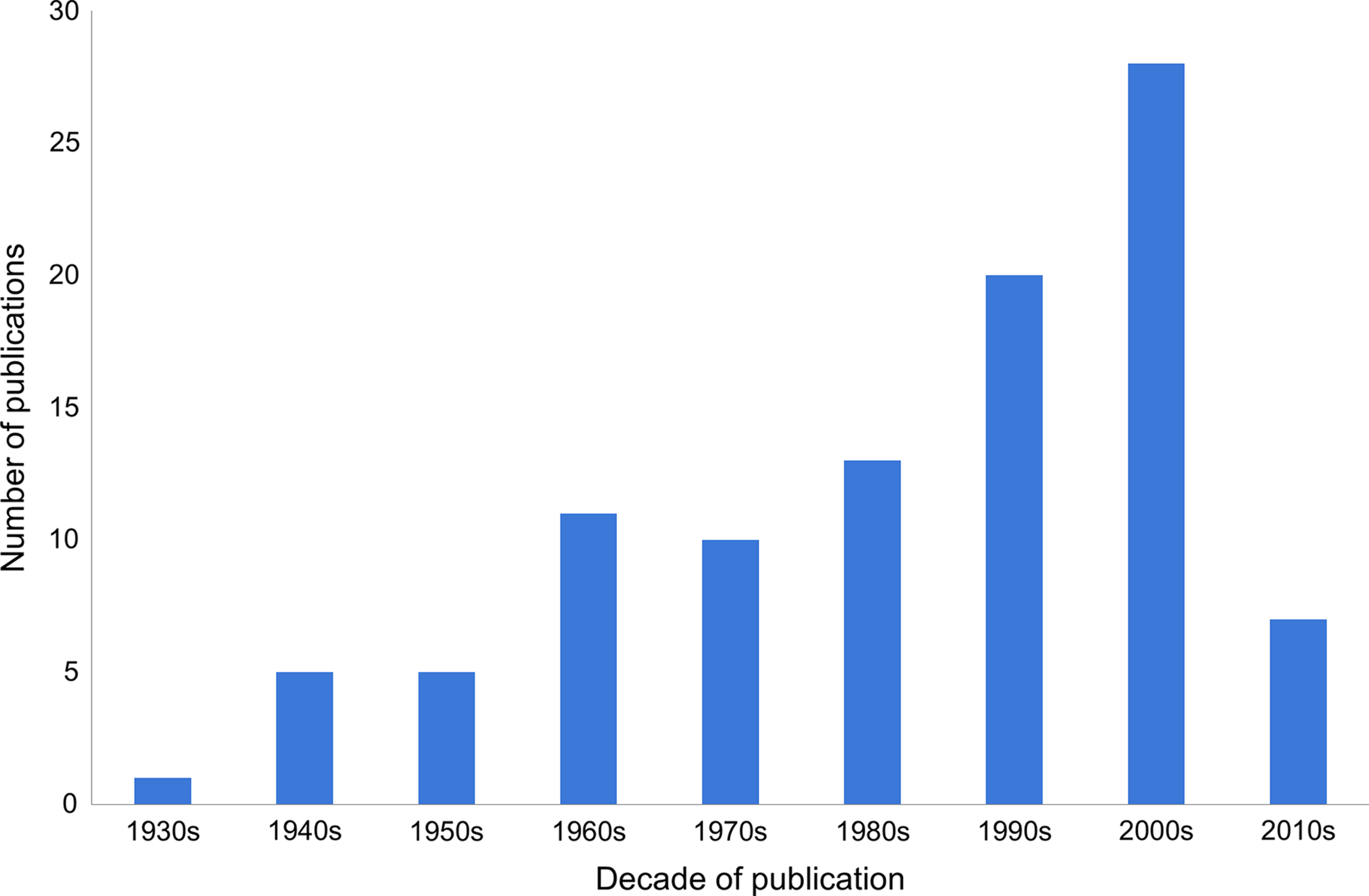
Figure 1. Number of articles in the top 100 most cited, by decade of publication.
There were 542 individuals listed as authors, of whom 81 appeared more than once. Thirteen authors had four or more publications included in the list, as shown in Table 2; all these authors were based at four leading US centres for most or all their publications: Boston Children’s Hospital and Harvard University; Children’s Hospital of Philadelphia and University of Pennsylvania; University of California San Francisco; and/or University of Texas Southwestern Medical Center. The leading paediatric cardiologists were Dr Jane W Newburger (9) and Dr Gil Wernovsky (8), and the leading surgeons were Dr Richard A Jonas (6), Dr Thomas L Spray, and Dr J William Gaynor (5 each). Fifty-nine papers reported specific funding, with the US National Institutes of Health cited as the sole or a contributing funder in 28 articles.
Table 2. Authors with 4 or more articles in the 100 most cited
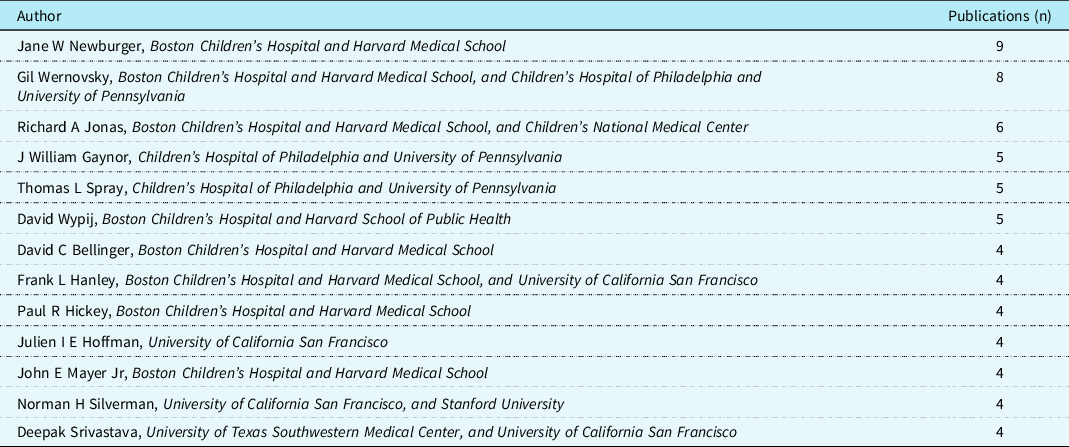
CHD overall was the most considered disease group (46 articles), followed by the spectrum of single-ventricle heart conditions (11), transposition (8), septal defects (7), and patent arterial duct (6). The most common subject was surgical outcomes (19), followed by pathology (18), surgical technique (13), epidemiology (12), and catheter intervention (9) (Table 3). There were 86 original research articles, including 50 case series, 14 cohort studies, and 10 clinical trials (Table 4); one additional case series was published as a conference abstract. The level of evidence of articles by decade of publication is shown in Figure 2, with level 4 evidence predominant before the 1980s and level 3 evidence most prevalent in more recent decades; all bar one of the most cited level 1 evidence has been published in the last 30 years.
Table 3. Subjects of studies in the 100 most cited
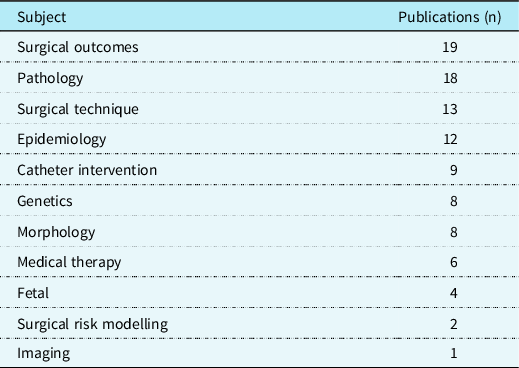
Table 4. Types of studies in the 100 most cited
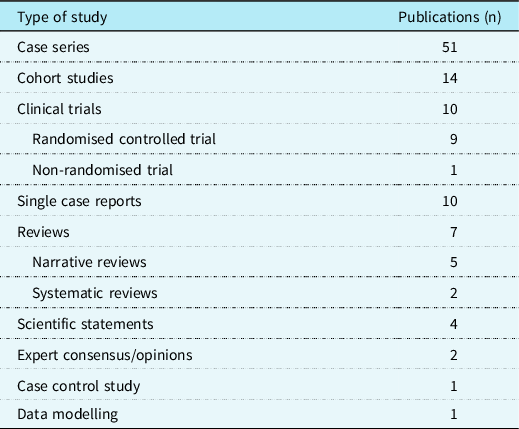
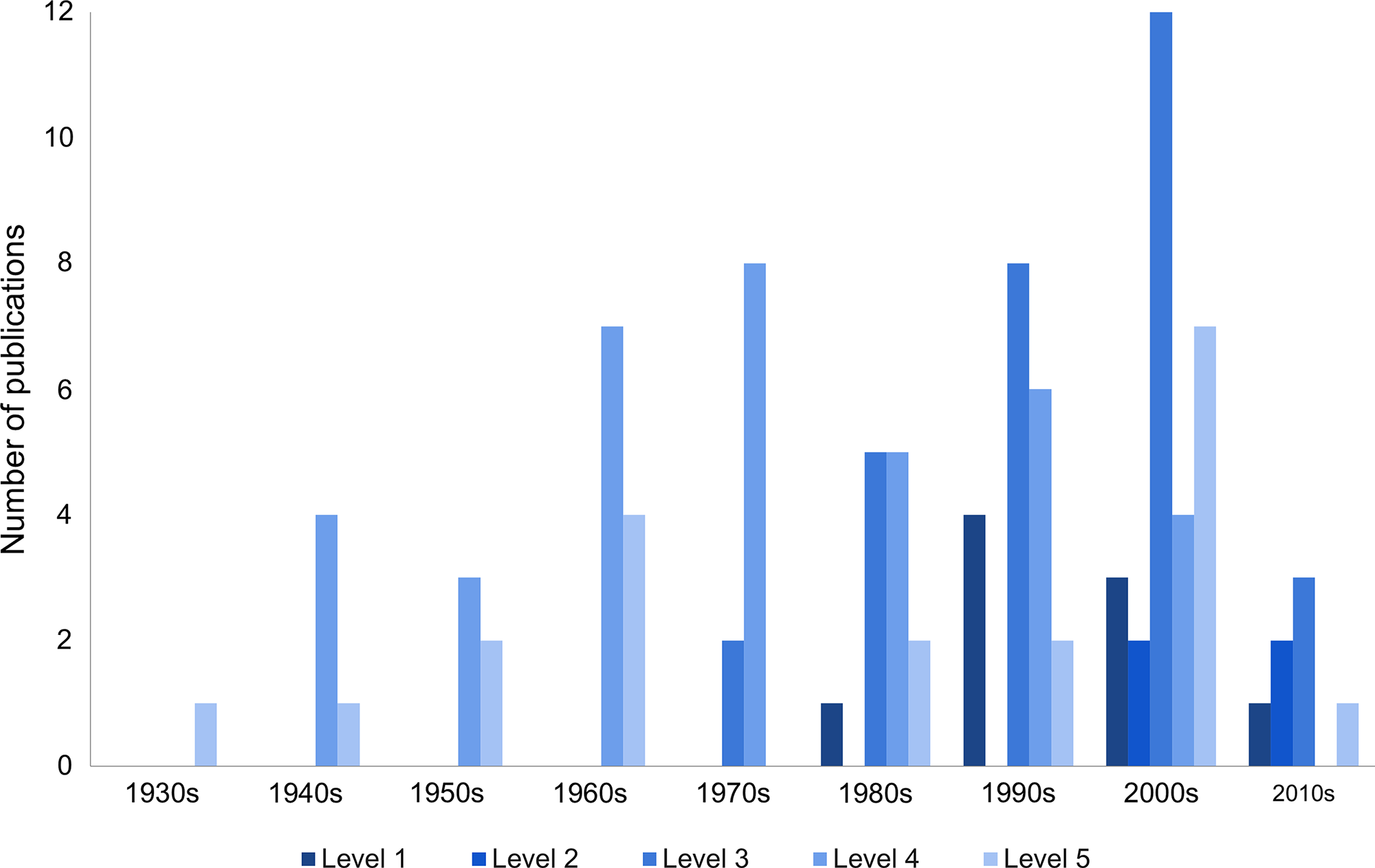
Figure 2. Level of evidence of articles in the top 100 most cited, by decade of publication.
Discussion
The number of times that a published article is cited in the literature reflects its influence and impact over time. Reference Garfield1 Citation counts are being used increasingly as a tool to assess, rank, and compare individuals, institutions, and journals through metrics such as h-index and impact factor. Reference Abbott, Cyranoski, Jones, Maher, Schiermeier and Van Noorden5 These measures assume that influential researchers and important publications are cited proportionately more often than those of lesser value, providing a measure of impact on the scientific field over time. There is marked variability in the rate of accumulating citations amongst highly cited papers with some peaking early before falling away, whilst others have a long rise to prominence. Reference Van Noorden, Maher and Nuzzo2 In this study, we identified the most cited papers on CHD in children, spanning 75 years, from Robert Gross and John Hubbard’s landmark 1939 study on surgical ligation of a patent arterial duct in Boston, MA, Reference Gross and Hubbard6 to Ariane Marelli and colleagues’ 2014 paper on the lifetime prevalence of CHD in Quebec, Canada. Reference Marelli, Ionescu-Ittu, Mackie, Guo, Dendukuri and Kaouache7 Whilst many historical classics remain relevant today, one in three of the most highly cited articles was published in the last 20 years.
Types of highly cited study
Much of modern clinical practice in paediatric cardiology and cardiac surgery is based on expert opinion and institutional case series, Reference Mahony, Sleeper and Anderson8 as reflected by the presence of 61 case reports or series amongst the most cited. Many of the older articles were the classic descriptions of syndromes, such as Williams (727 citations), Patau (563), Cantrell (504), Edwards (500), Alagille (475), and Noonan (408). Similarly, seminal reports of eponymous operations or interventions featured prominently, including Fontan (1631 citations), Blalock and Taussig (837), Mustard (527), Rashkind (523), Senning (490), Norwood (473), and Ross (316). Whilst these procedures remain relevant today and continue to attract attention, it is unlikely that such reports published today would have a similar impact.
Twelve of the top 100 articles were epidemiology studies, including 5 of the top 20 with over 5700 citations between them. Incidence, prevalence, and natural history are often quoted by authors in their introduction as a way of setting the scene, leading to high numbers of citations for those studies that break through and become the standard reference.
Only nine articles reported the outcomes of randomised controlled trials and five of these were on the early and late findings from the Boston Circulatory Arrest trial, Reference Newburger, Jonas and Wernovsky9–Reference Bellinger, Wypij and duPlessis13 totalling 2294 citations and involving 8 of the 12 authors appearing in Table 2. The other highly cited randomised controlled trials were the Pediatric Heart Network’s multicentre Single-Ventricle Reconstruction trial (463 citations), Reference Ohye, Sleeper and Mahony14 a national trial of indomethacin in pre-mature infants with a patent arterial duct (427), Reference Gersony, Peckham, Ellison, Miettinen and Nadas15 the multicentre PRIMACORP study of prophylactic milrinone after surgery (404), Reference Hoffman, Wernovsky and Atz16 and the first clinical application of remote ischemic pre-conditioning for myocardial protection (387). Reference Cheung, Kharbanda and Konstantinov17 The low numbers of randomised controlled trials on the list may reflect the lack of late-phase, practice changing trials in paediatric cardiology and cardiac surgery, Reference Gidding18,Reference Drury, Patel and Oswald19 or that clinical trials address specific research questions, and therefore the findings have a narrower appeal. However, all bar one of these trials were published in the last 30 years yet have garnered sufficient citations to enter the top 100 most cited articles in the field.
Over recent years, clinical guidelines endorsed by national or international bodies have emerged as a key resource for patient management. Four scientific statements from the American Heart Association were included on the list, and it is likely that the number of such articles amongst the most cited will increase in the coming decade.
Origins of highly cited studies
We found that the most cited articles on structural CHD in children were all published in English and dominated by clinical research groups in the United States, as found in other areas of cardiovascular disease Reference Usman, Siddiqi and Khan20,Reference Chan, Mak, Chu, Hui and Kwan21 ; only 16 involved authors from non-English speaking countries and 4 originated from outside Europe or North America. Most articles were publishing in US-based cardiovascular journals, whilst almost a quarter appeared in high-impact general medical (17) or non-clinical scientific (7) journals. It is not surprising that of those rapidly rising studies published in the last 15 years, 14 of 16 (88%) were published in high-impact specialty or general medical journals.
The observation that all authors featuring four or more times had worked at one of four US institutions for most or all their impactful publications reinforces the benefits of “team science.” These groups established and sustained successful and collaborative research programmes, where success breeds success, although multiple highly cited papers originating from one clinical trial contributed much to this achievement. However, it also raises the possibility of a publication bias in which work from leading US institutions is favoured by leading US journals.
The most highly cited papers
At the time of our search, three papers had generated over 1000 citations. Julien Hoffman and Samuel Kaplan’s article on the incidence of CHD was by far the most cited with 2,522 citations. Reference Hoffman and Kaplan22 Published in 2002, it is likely to retain this position for many years, although the systematic review and meta-analysis on worldwide prevalence by Van der Linde and colleagues from 2011 is rising fast, already in fourth place with 990 citations. Reference Van der Linde, Konings and Slager23 The second most cited paper was a surgical classic from 1971, Fontan and Baudet’s original description of ventricularisation of the right atrium to direct inferior vena caval blood to the left lung, receiving 1631 citations Reference Fontan and Baudet24 ; the evolution and outcomes of the Fontan procedure have remained the focus of intense research over the last five decades. In third place was Philip Hagen and colleagues’ 1984 autopsy study on the incidence and size of patent foramen ovale by age in children and adults and has grossed over 1500 citations. Reference Hagen, Scholz and Edwards25
Strengths and limitations
This study provides a unique insight into the most influential peer-reviewed publications that have shaped the development of our specialty over the last 100 years, providing a reference list that will be of interest to students, clinicians, and researchers. Our comprehensive search of a wide range of journals listed on the expanded Science Citation Index is likely to have missed few if any of the most cited papers. However, our findings are limited by our use of only one bibliometric tool to determine citation counts; other databases, such as Scopus or Google Scholar, use different data sources and algorithms which may impact on the number of citations detected and therefore which papers appear in the top 100 Reference Falagas, Pitsouni, Malietzis and Pappas26 although as both index fewer articles published prior to the 1990s, they are less suited to historical analyses. Similarly, metrics related to other sources of information, such as number of times accessed online and twitter engagements, were not assessed but are much more relevant to recently published works. Citation analysis demonstrates the overall impact of a paper since publication but is not adjusted to account for its current influence or its quality; infamous papers may receive as much attention as celebrated papers. Like any bibliometric analysis, our findings are a snapshot in time, a now historical view on the most cited articles in the field. Since our search, recently published articles, such as Zaidi et al. in Nature 2013 (426 citations) Reference Zaidi, Choi and Wakimoto27 and Marelli et al in Circulation 2014 (348), Reference Marelli, Ionescu-Ittu, Mackie, Guo, Dendukuri and Kaouache7 will have continued their rapid rise, whilst others, such as the scientific statement by Pierpont et al. in Circulation 2007 (516), Reference Pierpont, Basson and Benson28 have been superseded by updated reviews Reference Pierpont, Brueckner and Chung29 and are therefore likely to plateau. As a time-dependent process, other groundbreaking but recently published articles may have had too little time to accrue sufficient citations to make our list.
Conclusions
This study identified the most influential papers on CHD in children, providing a historical perspective on scientific progress over the last century. Our findings demonstrate that highly cited papers are exclusively published in English, and that researchers and journals based in the United States hold a dominant position in this field. Most of the highly cited articles remain case series, with few randomised controlled trials in CHD appearing in recent years.
Supplementary material
To view supplementary material for this article, please visit https://doi.org/10.1017/S1047951121001256
Acknowledgements
The authors thank Dr Lynne K Williams, Papworth Hospital, Cambridge, and Miss Vanessa JC Rogers, Queen Elizabeth Hospital Birmingham for their input to the methodology.
Authors contributions
NED devised the study. Both authors undertook data acquisition, data analysis, data interpretation, and manuscript preparation.
Financial support
Nigel Drury is funded by an Intermediate Clinical Research Fellowship from the British Heart Foundation (FS/15/49/31612). The authors received no specific funding for this study.
Conflicts of interest
None.











